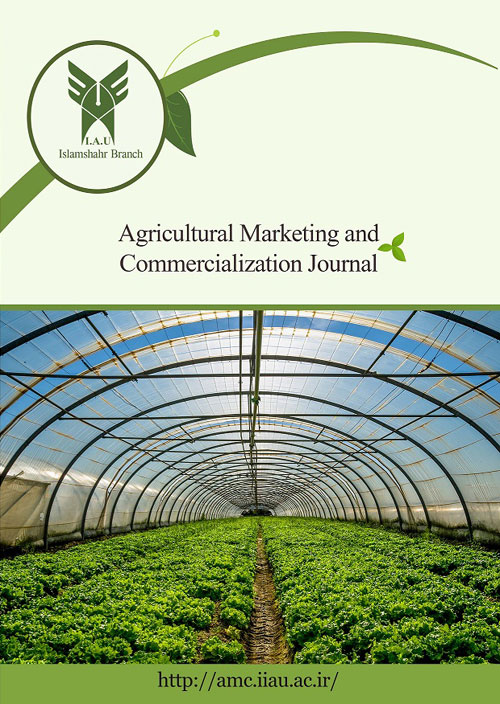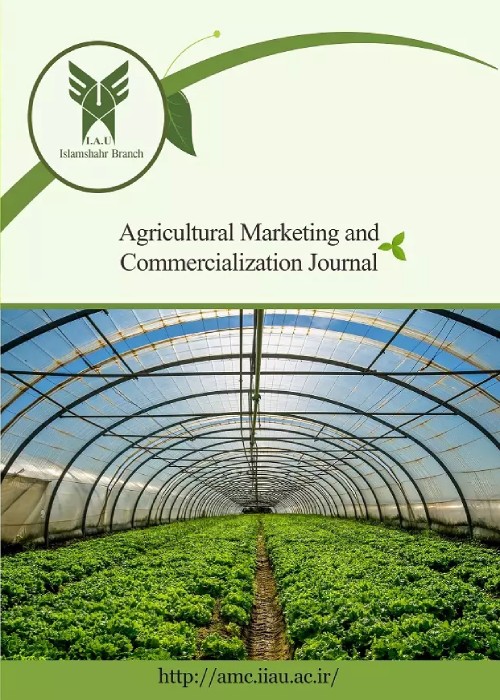فهرست مطالب

Agricultural Marketing and Commercialization Journal
Volume:2 Issue: 2, Summer and Autumn 2018
- تاریخ انتشار: 1397/08/10
- تعداد عناوین: 3
-
Pages 1-6
Application of an appropriate harvesting time in forage crops plays an important role in yield production, so that if the crop is not harvested timely, the yield decreases even in case of foliar application. Effects of different harvesting times on the yield and protein content of Bami alfalfa were investigated here under foliar application in a split-split plot experiment in time unit based on complete random block designs with four replications in Shahid Zendeh Rooh Kerman Agricultural Research Center (10 km of Jopar road) during 2013 crop year. The Bami cultivar used here was harvested in four different cuttings. The uppermost yields were respectively 6.98, 8.5, 9.3, and −10 for fresh forage, and 24.85, 29.86, and 29.4 for the dry matter. The highest leaf-to-stem ratio was obtained in the first cutting. The first and second cuttings contained the highest (29.73%) and lowest (24.85%) dry matter contents, respectively. Dry forage yield was uppermost (6 t/ha) in the first cutting. Protein levels varied in different cuttings, with the second and fourth cuttings having the highest value (18%). The interaction of Bami alfalfa in different cuttings revealed the superiority of the second cutting to the other ones. This cultivar also had the highest values in some traits among the other cuttings; as a result, Bami cultivar can be superior to other cuttings in Kerman region.
Keywords: Cutting, dry matter content, dry forage yield, alfalfa -
Pages 7-17
Considering the importance of chicken meat production as a strategic protein product, it is necessary to pay attention to the effective managerial-economic factors in strengthening the poultry industry. The purpose of this study was to investigate the managerial-economic factors affecting the poultry production process in Qom province, including five parts: Central section, Salafchegan, Kahak, Jafarabad, Khalajestan; It is during the years 1393-1390. The required data were collected by completing a researcher-made questionnaire with validity and reliability approved by the managers of selected poultry units. The collected data were analyzed using Ewiews7 and Excel software. The main findings of this study show that the variable of production capacity, variable of feed value and variable of working capital have a positive and significant effect on the amount of production in selected production units. The variable of production and administrative payments has a negative and significant effect on the amount of production and also the amount of production has the highest sensitivity to working capital and the least sensitivity to production capacity.
Keywords: Meat Poultry, Cobb Douglas Production Function, Economic, Managerial Factors, Qom Province -
Pages 18-27
Agricultural joint stock companies and production cooperatives are one of the forms of exploitation systems after the land reform, and the dissatisfaction of the peasants for various reasons at the beginning of the revolution led to the dissolution of many of them. After three decades, some regional and national experts have shown concern for their revitalization, because they believe that by solving the previous problems of these companies, the goals of modernizing agricultural and rural development can be achieved in the programs after the victory of the revolution. Kamyaran Agricultural Joint Stock Company is one of the five companies retained after the victory of the Islamic Revolution and Golshan Production Cooperative is the only company established after the victory of the Islamic Revolution in the city. In the present study, an attempt has been made to investigate the economic, social, cultural and welfare effects of these two companies on rural development in the covered villages. This research has been done with a descriptive-analytical approach. The required data and information were collected using a questionnaire through statistical samples and library resources and materials. The study area is the villages covered by two companies and due to the limitations of the members of the study community, the census method has been used. Statistical data were analyzed in SPSS environment using correlation, Mann-Whitney, Kruskal-Wallis and regression tests.
Keywords: Rural Development, Agricultural Development, Agricultural Joint Stock Company, ProductionCooperative


